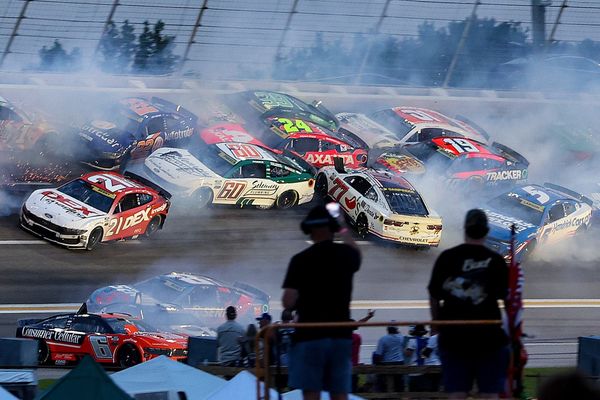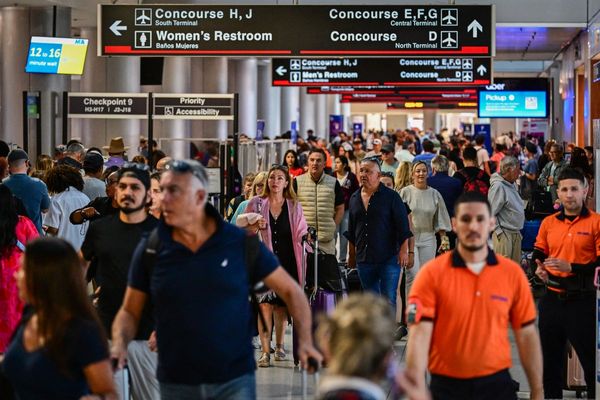
After years of dashed hopes, delays and the all-consuming dominance of the car and airplane, high-speed trains may finally be about to have their breakthrough moment in the United States, according to one of the country’s top rail executives.
Half a dozen high-speed rail projects across the US are currently planned or have already started construction, with a gush of federal infrastructure dollars, a supportive White House, and rising angst over snarled highways and the climate crisis all helping bring the prospect of bullet trains, belatedly, closer than ever before to the American public.
“This is the golden opportunity for the US to join that high-speed club with all the benefits that it would bring,” said Andy Byford, a British executive who was nicknamed “Train Daddy” during a spell overseeing New York City’s subways. Since last year, he’s been senior vice-president of high-speed rail at Amtrak. “There’s no question the US is for now the outlier when it comes to high-speed rail.
“But I think once we get one route up successfully, people will clamor for more. We believe the time is right for this where the topography, population and so on makes sense. I think if it’s not going to happen now, I wonder if it ever will.”
High-speed trains, capable of 200mph (322km/h) or more, have long become commonplace in countries including France, Germany, Japan and even Morocco. Yet the US, despite being an early rail pioneer, has instead prioritized the build-out of vast and ever-widening highways, often choked with traffic and rammed through razed neighborhoods, supplemented by a matrix of flights linking even relatively close cities.
This is gradually changing. In April, work started on building a high-speed rail project connecting Las Vegas to southern California, promising 200mph trains that will cut the normal four-hour drive time in half by the time of the Los Angeles Olympic Games in 2028. “If they pull it off it will be remarkable,” said Byford. “That would be practically a mile a day [of track] construction.”
California has another high-speed rail project that has labored under grueling delays and ballooning costs over the past decade that aims to connect Los Angeles and San Francisco. Projects in the earlier stages of planning include efforts to link Atlanta, Georgia, to Charlotte, North Carolina, as well as Chicago, Illinois, to St Louis, Missouri, and Vancouver, British Columbia, to Portland, Oregon.
Brightline, the company behind the Las Vegas to California route, has already completed a line running from Miami to Orlando, Florida, running at slower, but still brisk, pace of 125mph, while Amtrak is looking to expand its class of east coast trains that can currently get to 150mph.
Byford, meanwhile, is spearheading an Amtrak program to revive a moribund plan connecting Dallas and Houston with a high-speed track that will run the fabled Japanese Shinkansen bullet trains, offering people who have to drive three and a half hours down the I-45, one of the deadliest roads in the US, the option of a 205mph journey that will take about 90 minutes, with a stop at Texas A&M University between the two cities.
“These trains would have the highest average speed in the world, which would be a real source of prestige for the state of Texas if we were able to go ahead,” Byford said. “We believe there is a very, very strong case.”
Amtrak estimates the whizzing trains would remove 12,500 cars from the clogged I-45 as well as negate flights making the relatively short 240-mile hop, slashing planet-heating emissions. For those who want to spend a full day of their lives traveling from Dallas to Houston by train, there are currently two Amtrak services each day that go via San Antonio, taking, with a lengthy stopover, an incredible 23 hours in total, about an hour more than it would take to bicycle between the two cities.
The prospects for high-speed rail have been buoyed by recent support, such as the federal bipartisan infrastructure law that retained much of the American fixation upon funding roads but also provided a cash injection to rail. In December, Joe Biden, once known as “Amtrak Joe” due to his regular use of trains when he was a US senator, announced $8.2bn to secure rail corridors to accelerate the building of high-speed rail in what the White House called “historic investments in world-class rail”.
Major barriers remain for high-speed rail, however. “I’m not going to sugarcoat the remaining challenges,” Byford said of the Texas project, which still needs to acquire about 80% of the land needed for its route, get federal permission to use Japanese trains, pass environmental reviews and then raise, via partnerships with private companies and others, the $30bn or so needed to build a system that, in the most optimistic scenario, will be completed by 2031.
Eye-watering costs and delays have dogged the California scheme, meanwhile, which has rocketed from a $33bn to at least a $113bn project amid contentious re-routes and political wrangling. Opponents of high-speed rail have found reliable allies among Republicans in Congress, who complain it is an expensive indulgence that tramples upon the property rights of rural Americans.
“If you want to look in the dictionary, under the word ‘boondoggle’, you would probably find the California high-speed rail project process,” said Doug LaMalfa, a California Republican congressman. In May, the two top Republicans in the House and Senate transportation committees, Garrett Graves and Ted Cruz, wrote to the US Department of Transportation criticizing the administration’s support for “this highly questionable endeavor”.
In Texas, opposition from landowners, hostile state lawmakers and lobbying airlines sank a previous effort to bring high-speed rail between Houston and Dallas, along with a mooted extension to Austin and San Antonio, in the 1990s. Texas Central picked up the idea of the Houston to Dallas line in 2009, only to put the plan on ice following court challenges and the Covid pandemic in 2022, before its resurrection under Amtrak.
Building any sort of rail is difficult in a state with a particular zeal for the primacy of cars, with 97% of Texas’s entire transport budget, by law, going to the expansion and maintenance of roads. “People are flocking to Texas and we can’t just keep widening our highways forever,” said Peter LeCody, president of Texas Rail Advocates. “More people are understanding this but it’s been very slow going. We may now be starting to crawl before we walk and then run.”
Objections remain, with Byford recently traveling to a ranch near Dallas to meet the Texans Against High-Speed Rail group, to assure them Amtrak wouldn’t use eminent domain to secure needed farmland except as a last resort. Some lawmakers remain unimpressed.
“This project does not only impact rural Texas but all of the United States,” said Jake Ellzey, a Republican congressman who represents a district in the path of the planned rail route. “In a time of a global food shortage, we cannot allow our farmland to be destroyed, and taxpayer dollars squandered for an unsustainable and unnecessary project like this.”
Still, optimism is growing among supporters of high-speed rail. Byford is deluged by emails from enthused rail fans suggesting sometimes outlandish ideas, such as bullet trains from New York to Los Angeles, but he can envision a more realistic future of swift connections between US cities lying in the “sweet spot” of distance from each other, about 200 to 600 miles apart.
“There are so many cities like that in the US, just in the right zone for high-speed rail,” said Byford. “I hope that we will be able to deliver a network around the north-east, Florida, Texas, on the west coast and the midwest. There’s lots of great city pairings.”
Most Americans “don’t know the joy of going downtown to downtown over 200mph without having to go out to the airport, having to line up in security, and then taxi on the runway and take off and land probably miles away from where you actually want to be”, Byford said, adding that the experience of avoiding traffic jams or strolling from a cathedral-like train station to get a meal and a drink also remains a largely foreign concept.
“You don’t know what you’re missing,” he said. “I think now is our best opportunity to deliver that, there’s no question.”







